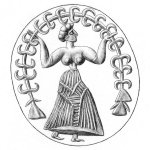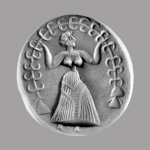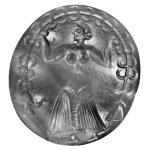Documentation
The material in the series is organized according to where it is kept. Volumes CMS I-V are devoted to material kept in the Greek collections, CMS VI-XI to that of other European collections, and CMS XII-XIII to the North American collections. Six of the supplementary volumes (Beihefte) report proceedings of conferences organized by the CMS. The remaining four supplements are publications of studies devoted to Aegean glyptic and sealing administration.
Each seal entry in a CMS volume is accompanied by a photograph of the seal face, one of its impression, and a drawing of the impression. When necessary, a photograph of the seal showing its shape is also published. Ancient seal impressions are documented by a photograph of the seal impression and its drawing. The photographs used are black and white and published in a standard size such that comparisons between the material are easily made (4,5 / 6,2 x 4,5 cm). Profile drawings of Late Bronze Age seals can be found in tables at the end of each volume.



The lentoid CMS V Suppl. 3 no. 85
The photograph of the seal face/seal is intended to give the observer an impression of the material used and of the state of preservation of the seal. The impression renders the engraved image mirror inverted and in relief. By studying the impression, it is possible to detect iconographical, stylistic, and technical details of the intaglio in every possible detail without being disturbed by the irregularities of the material. Drawings are prepared from impressions with the help of a microscope. They can be seen as complementing the impressions as they render the motif independently of the illumination which is intrinsic to photography and can also illustrate ambiguous parts of the intaglio with greater clarity. In the case of ancient seal impressions, the drawing may also enable the reconstruction of a seal face from a synthesis of the various fragments of the impressions of one seal.
The information provided for each seal is its repository, inventory number, material, shape, dimensions, and where available, provenance and context. A description of the motif follows. In the latest volumes, a commentary and comparanda have been added, when necessary. References to the most important scholarly contributions available for each piece are also provided.
The introductory section considers the various aspects of the material included in each volume, such as its provenance, dating, iconography, style, technique, and even authenticity issues. Some introductions constitute separate studies themselves. For example the introductions devoted to the Agia Triada and Knossos sealings in CMS II,6 and CMS II,8 as well as that treating the materials and shapes of the seals in CMS III all represent studies in their own right.


